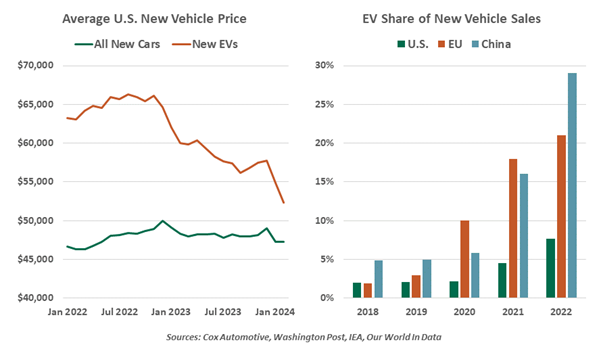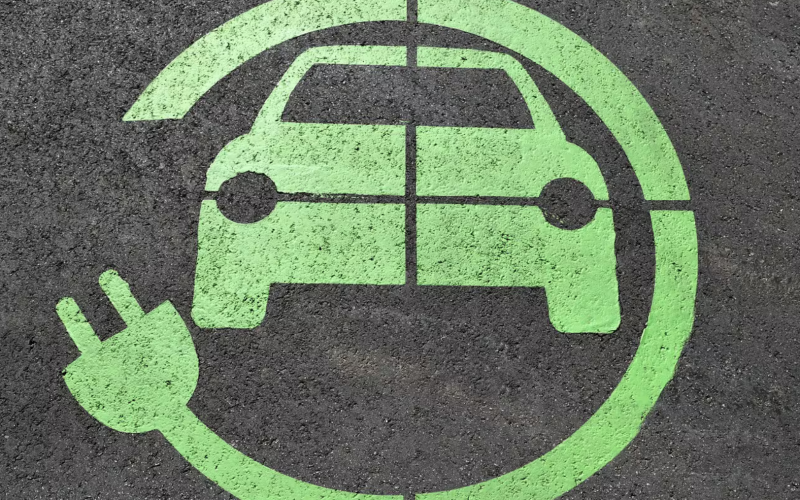by Ryan James Boyle, Senior Economist, Northern Trust
More charging stations and lower prices can break EV sales out of their slump.
Students of science and history will recognize December 17, 1903 as the date the Wright Brothers proved that a self-powered, heavier-than-air machine could take flight. But the discovery did not happen overnight, nor did the modern aircraft industry emerge in a day. The Wrights logged three years of failed experiments at Kitty Hawk before they flew. They needed another five years before taking a passenger in the air and getting interest in the machine from the U.S. War Department.
Human flight is ubiquitous today, making it easy to overlook the years required for the technology to become mainstream. Electric vehicles (EVs) are the latest example of a transportation technology which may take a long time to gain traction.
EV owners rave about their vehicles’ performance and lack of direct emissions. Their satisfaction increases in tandem with gasoline prices. But EVs have not yet won over a broader segment of consumers. Buyers’ skepticism is reflected in this week’s pared-back U.S. emission targets. How can automakers and policymakers reduce emissions by encouraging more EV purchases?
Range anxiety is a major reason for hesitation to commit to an EV; most models can’t exceed 300 miles on a full charge. This was an issue in the early days of motoring, as well, when distilled petroleum was sold in cans at hardware stores. That worry was resolved by the mass construction of service stations. Compared to the ready availability of motor fuel, EV charging networks are nascent and sparse. Public chargers have varying costs, speeds, connections and states of repair.
The need for chargers is not solely to put long-distance travelers at ease. Most car trips start and end close to home, where charging requires dedicated, off-street parking that is not available to everyone. While the U.S. is making progress building EV chargers, the most rapid growth has been at hotels and auto dealerships, not locations where most people live and work.
Building infrastructure is a natural role for industrial policy to fill. The Infrastructure Investment and Jobs Act (IIJA) of 2022 allocated $7.5 billion for a nationwide charging network. Only 2% of those funds have been used. As of last December, 27 states had not even begun soliciting bids. The long runway of unspent funding promises years of network enhancements ahead, but also gives potential buyers more reason to wait to make their purchase.

"A better network of chargers will help overcome some EV skepticism."
Even if charging were more convenient, EV buyers have had to overcome sticker shock. Batteries represent 40% of the cost of a typical EV. EV prices are falling as battery technology continues to improve; the U.S. Department of Energy estimates the cost of batteries fell 90% from 2008 to 2022. Longer ranges and lower prices may await those who defer their EV purchases.
The federal government has long offered tax credits to offset EVs’ higher prices, but the Inflation Reduction Act of 2022 narrowed the eligibility for those credits. The full $7,500 credit is only available to vehicles assembled in the U.S., using critical minerals sourced domestically. The list of vehicles eligible for even partial rebates is short. Manufacturers are retooling to produce EVs in the U.S., and tax rebate eligibility will grow. But this is yet another reason for buyers to be patient.
The slow launch of the U.S. EV industry has left a gap for competitors to fill. China has seized on EVs as their next productive frontier, a category that can help break the nation out of its looming malaise. China’s new EV sales increased by 82% in 2022, with domestic demand supported by a massive buildout of charging stations. Tariffs may keep China’s EVs away from U.S. ports, but its automakers are investing in factories in Mexico to build for the North American market.
Future generations may look back on internal combustion engines the way we think of slide rules or steam locomotives: the best technology of its time that gave way to better-performing alternatives. The takeoff has not been smooth, but the EV market is still poised to take flight.
Copyright © Northern Trust
















